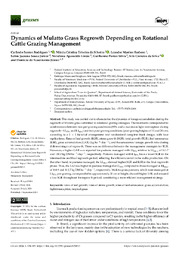Dynamics of mulatto grass regrowth depending on rotational cattle grazing management.
Dynamics of mulatto grass regrowth depending on rotational cattle grazing management.
Author(s): RODRIGUES, C. S.; SILVEIRA, M. C. T. da; BARBERO, L. M.; SOUSA JÚNIOR, S. J.; LIMÃO, V. A.; SILVA, G. P.; SILVA, S. C. da; NASCIMENTO JÚNIOR, D. do
Summary: This study was carried out to characterize the dynamics of forage accumulation during the regrowth of Mulatto grass submitted to rotational grazing strategies. The treatments corresponded to combinations between two pre-grazing conditions (95% and a maximum light interception during regrowth—LI95% and LIMax) and two post-grazing conditions (post-grazing heights of 15 and 20 cm), according to a 2 × 2 factorial arrangement and randomized complete block design, with four replications. Rates of leaf growth (LGR), stems growth (SGR), total growth (TGR), leaf senescence (LSR), grass accumulation (GAR) (kg·ha?1 ·day?1 ), and the senescence/canopy growth ratio during different stages of regrowth. There was no difference between the management strategies for TGR. However, a higher GAR was reported for pastures managed with LI95% relative to LIMax, of 161.7 and 120.2 kg DM ha?1 ·day?1 , respectively. Pastures managed with LI95% have a lower SGR in the intermediate and final regrowth period, reflecting the efficient control in the stalks production. On the other hand, in pastures managed, the LIMax showed higher SGR and LSR in the final regrowth phase. Thus, the LAI was higher in pastures managed at LI95% compared to those managed at LIMax, of 163.9 and 112.7 kg DM ha?1 ·day?1 , respectively. Mulatto grass pastures, which were managed at LI95% pre-grazing, corresponded to approximately 30 cm in height, showed higher LAI, and ensured a low SGR throughout the regrowth period, constituting a more efficient management strategy
Publication year: 2024
Types of publication: Journal article
Unit: Embrapa Maize & Sorghum
Keywords: Capim, Caule, Folha, Gado, Grama, Gramínea Tropical, Pastejo Rotativo, Senescência, Taxa de Crescimento
Observation
Some of Embrapa's publications are published as ePub files. To read them, use or download one of the following free software options to your computer or mobile device. Android: Google Play Books; IOS: iBooks; Windows and Linux: Calibre.
Access other publications
Access the Agricultural Research Database (BDPA) to consult Embrapa's full library collection and records.
Visit Embrapa Bookstore to purchase books and other publications sold by Embrapa.

